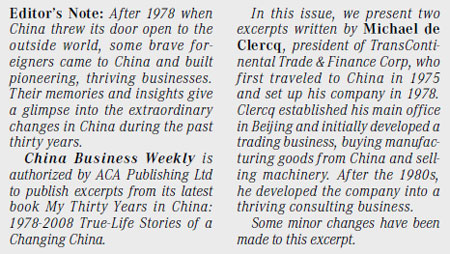

It's all a matter of perspective. If Marco Polo had had the ability to send a message and have it instantly received on the other side of the world, he would have made a fortune. The notion that one could do this would have seemed unbelievable at the time, bordering on magic.
But in these days of VOIP, voice over Internet protocol, and instant e-mails on a Blackberry, the telex system we used to use in China seems positively antediluvian. Incredible new technologies have become commercially available during the past thirty years and have had a direct impact on business in China.
The fact that China's growth has been in near lockstep with the phenomenal efficiency improvements of the communications industry is so remarkable that it calls for a cause-and-effect analysis. But not now: such a study exceeds the scope of this piece.
Our ability to communicate, rapidly, clearly, inexpensively and efficiently, is directly affected by the tools that are available to us. In the 1970s and early 1980s we used the telex. Later on in the 1980s, the personal computer surfaced and the fax machine became available, and communications improved and expanded.
Communications explosion

When the Internet gave us e-mail in the late 1990s, the combination of a dramatic increase in both the quality and scope of communications, accompanied by a large decrease in costs, led to an explosion in the volume of communications to and from China.
The telephone, which was available from the very beginning of my China experience, was not a major factor for us in international communications because it was expensive and left no records. But it was an important tool for communicating within China with FTCs (foreign trade corporations) and factories.
The fact that we located our main office in Beijing was partially driven by the fact that the capital was linked by phone with all major towns in China. The country benefited from the Fourth Five-Year Plan (1971-75), which had emphasized the development of communications.
Progress continued rapidly over time, especially after the mid-1980s, mostly with the installation of optical lines and the advent of mobile phones, which became both an efficient tool and a status symbol.
During my formative years, the only way to communicate was by telex. It was also known as the teletype machine, and first started to be used in a global network back in the 1920s.
The technology improved through the 1950s and 1960s, and the new machines in the late seventies were quite slick. But the old telex machines we used in China were owned by the State and were only available for rent.
They reminded you of the ancestor of motor cars, the Model T Ford. I figured that the Chinese must have acquired the earliest models because they actually looked like they were from the 1920s. They were robust, heavy and clunky, and available in any color as long as it was black.
The machines worked on a system of perforated paper tape and were slow and cumbersome to use. If you made a mistake and realized it, you could correct it by typing back-space, back-space, back-space, crossing it out with a row of XXXXs and then laboriously typing in your correction.
However, the recipient on the other side of the world would see all that - messy at best. And if you noticed a serious mistake after the whole text was finished, you had to re-type it all from scratch; word processing was not available then. Sometimes errors got through despite your vigilance. See what happens when you drop the 'r' from the main subject in the phrase '100,000 dozen shirts'.
One line at a time
At the Canton Fair in Guangzhou, which I attended twice a year for one month each time, there was a telex room downstairs at the Dongfang Hotel, where you could perforate your messages on a tape, which you rolled onto a spool.
The result was a spool less than an inch thick and as wide as your message was long.
You then booked a line to your destination - and waited for a connection. Seven hours: that was my record wait in Guangzhou for one telex to New York.
You could not leave the telex office because you had no idea when your line would come through, and when it did you had to take it immediately. The wait had an upside: you weren't alone. You shared the space with as many as twenty seasoned businessmen who had been at the fair many times. There was an atmosphere of camaraderie among traders. Many had bottles of whisky and were willing to share. The stories would flow, yarn upon yarn of China trade stories, of great deals and those that went sour.
Back in Beijing, for years we had to go to the electronic communications building on Changan Avenue, on the other side of Tiananmen Square, to type our messages, then line up and wait just like in Guangzhou (but for much less time since there was less traffic).
We could not receive telexes, because we did not have a machine and so did not have an address. So, to receive messages, we had to ask an FTC if we could use their address instead.
We would go and pick up the telexes in the morning. This friendly system created challenges of confidentiality since the people we were negotiating with read our telexes before we did. For our counterpart to know what our client's position was on pricing was an awkward approach to subtle negotiations. So we developed a code system to address the issue.
We finally got our very own private telex machine in our new offices in the International Club in the 1980s. It was a brand-new, modern, light blue Siemens machine from which we could both send and receive telexes. We were one of the first companies to have this great luxury, which required a dedicated line as well as various approvals. It meant a huge jump in productivity.
But there were glitches too. Once my secretary had already left for the day and the telex line had dropped halfway through an outgoing message.
I had to reconnect and resend but, at $7 a minute, I did not want to resend the whole thing if some of it had already been well received. So I called the central number for telexes in Beijing, explained who I was and could they please tell me how many minutes had been sent?
The operator was most helpful: the line had dropped about halfway through the message, just after the words 'quota for the third shipment' How convenient: she had a copy of my telex right in front of her. It was nice to know that there was a back-up copy of your confidential telexes with the government in case you lost your original.
The fax of life
The telex system was abandoned around 1990 when it was overtaken by the fax (facsimile) machine, which operated over normal phone lines and only required you to get one machine for each end. We had one of the first faxes in Beijing too, which we had brought in from Hong Kong.
It was faster and more reliable than the telex, and it enabled us to send pictures and communicate with our US office using Chinese characters. The early models used rolls of a chemically-coated paper that we had to import and which had the annoying tendency to fade when exposed to light. Valuable fax records had to be photocopied onto normal paper or else you would open your files to find illegible, washed-out curly pages.
Faxes were also much more efficient partially because they tapped into the productivity of that other new tool: the personal computer. You could write your text with a word processor and send only the final printed version. Faxes were also more economical, many times cheaper than the telex.
But e-mails topped all that. They enabled us to send text, spreadsheets and other software, which could not only be read but could also be instantly modified on the other side of the world. They also allowed us to send high-density pictures and sounds - and in turn they were much cheaper than their fax predecessor.
China catches up
Times were changing, and China was embracing new technologies with gusto. There were all sorts of benefits. We had the new ability to make much better sales presentations, as well as providing customers with better sourcing services by sending them instant quality control pictures, for instance.
Investments were facilitated by excellent cellular phone connections, instant number crunching with laptops and inexpensive audio and video conferences through media such as Skype. The impact on trade was considerable. We tend to take all this for granted because we adapt so quickly to tools that are designed to be used without thinking. But my experience in China was marked and colored by the communications devices that I used in the early days.
As a final note, the depth to which technology has impacted China can be illustrated by one guy I noticed pushing a handcart full of junk in Beijing recently. The cart was the wooden kind with bicycle wheels and long handles. The man was dirty, wearing faded blue and grey clothes, ill-fitting and torn, one of the numerous poor. But then he stopped, dug in his pocket and pulled out a cell phone. I like to think he was checking on his stock investment.

(China Daily 11/24/2008 page2)













